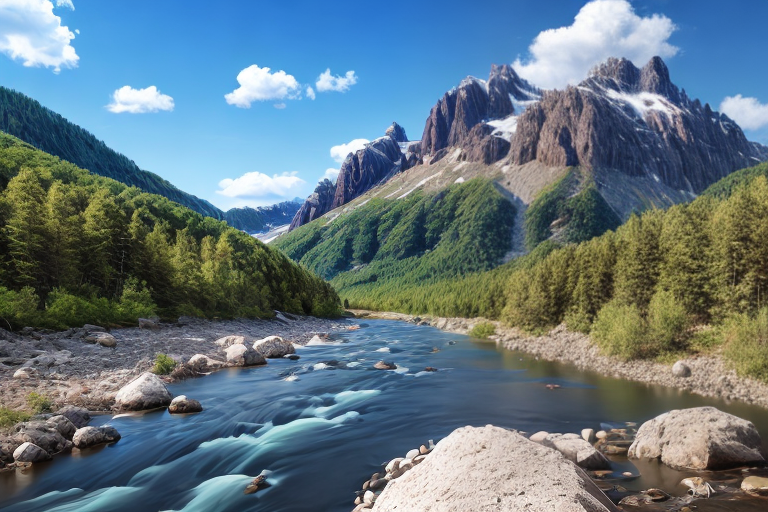
When it comes to identifying and filtering natural water sources, there are some important factors to consider. Understanding the different categories of natural water sources, such as rivers, lakes, springs, and wells, is crucial as each has its own distinct characteristics and potential pollutants.
To recognize a natural water source, it is important to observe physical traits like location, appearance, and flow rate.
Evaluating the surrounding environment for possible pollution sources is also essential.
Once identified, filtering the water becomes necessary for safety. Utilizing techniques like water filtration, purification, and chemical treatments is vital, but it is important to select the appropriate method based on the specific pollutants present.
Consider the health risks associated with these contaminants.
Click here to learn more Survival Tips from Pro Outdoor Survival
Different sources of natural water
When it comes to identifying water sources, there is an abundance of options available in nature. From the pure and refreshing rainwater to the vast surface water bodies like rivers and lakes, and even the hidden underground aquifers, the Earth provides a multitude of sources for us to quench our thirst and sustain life.
Rainfall serves as one of the primary sources, offering the purest form of water, untainted by pollutants.
Surface water, on the other hand, includes rivers, lakes, and ponds, serving as a vital resource for various purposes.
Groundwater, found beneath the surface, is another significant source accessed through wells and boreholes. Glaciers and ice caps, though not easily accessible, are vital contributors, slowly melting and providing freshwater to rivers and lakes.
Lastly, natural springs emerge as unique sources, offering pristine water for our consumption and survival. Understanding these water filtration methods is essential for identifying safe water sources and filtering natural water.

Identifying safe water sources
When it comes to finding clean and safe water, it is important to consider several key factors. First and foremost, we must understand the significance of identifying water sources.
In today’s increasingly polluted world, it is crucial to know where and how to access natural sources of water.
By utilizing various methods to identify water sources and implementing effective filtering techniques, we can ensure the safety and purity of our water supply.
Using natural water filtration systems and purification methods can play a significant role in providing us with the clean and safe water we need for optimal health and well-being.
Key Factors for Finding Clean and Safe Water
- Identifying water sources is essential in today’s polluted world.
- Knowing where and how to access natural sources of water is crucial.
- Utilizing various methods to identify water sources ensures the safety and purity of our water supply.
- Natural water filtration systems and purification methods play a significant role in providing clean and safe water for optimal health and well-being.
Best natural water filtration methods
When it comes to ensuring clean and safe drinking water, utilizing natural methods to filter out impurities and contaminants can be highly effective. One of the most efficient ways to achieve this is by using activated carbon filters.
These filters, made from charcoal, have a porous structure that effectively traps and eliminates impurities like chlorine, pesticides, and heavy metals, resulting in healthy and purer water.
They also enhance the taste and odor of the water.
Another effective filtration method is the use of sand filters. These filters, comprised of layers of sand and gravel, efficiently remove sediment, bacteria, and other particles from the water source.
Particularly popular in rural areas, sand filters can be easily constructed using locally available materials. Certain plant species like water hyacinths and water lilies possess the ability to naturally filter water. These plants absorb impurities, contributing to cleaner and safer drinking water through their natural water filtration processes.
Importance of filtering natural water sources
Water purification processes play a crucial role in maintaining the safety and purity of drinking water obtained from natural sources. It is essential to accurately identify and purify these sources to eliminate harmful impurities and deliver uncontaminated and wholesome water for consumption.
There are various filtration methods available for water sourced from rivers, lakes, and streams, including activated carbon filters, sand filters, and the use of specific plants with natural filtration abilities.
By implementing effective procedures and techniques to identify water sources, appropriate filtration solutions can be applied to safeguard our health and well-being.
Water Purification
- Activated carbon filters are highly effective in removing organic compounds, chlorine, and volatile organic compounds (VOCs) from water sources.
- Sand filters can effectively remove suspended particles, sediment, and turbidity from water, improving its clarity and reducing the risk of contamination.
- Certain plants, such as water hyacinths and water lilies, have natural filtration abilities and can absorb pollutants like heavy metals, pesticides, and bacteria from water bodies.
- Implementing accurate procedures and techniques to identify water sources ensures that appropriate filtration solutions can be chosen based on the specific contaminants present, resulting in safer drinking water.
Purifying water from natural sources
Be the most sustainable option, as it requires a constant source of fuel and can contribute to carbon emissions. Similarly, chemical disinfection may not be ideal for long-term sustainability due to the potential environmental impact of the chemicals used.
One effective and sustainable method for purifying water from natural sources is filtration.
By using filters, contaminants such as bacteria, sediment, and particles can be removed, resulting in cleaner and safer drinking water.
Filtration systems can range from simple portable devices to more advanced one’s that utilize different filtration media.
UV treatment is another viable option for purifying water from natural sources.
This method utilizes ultraviolet light to kill harmful microorganisms, including bacteria and viruses, making the water safe for consumption. UV treatment is a chemical-free process and does not require the use of fuel, making it an environmentally friendly purification method. Purifying water from natural sources can be achieved through a variety of methods such as identifying and filtering natural sources of freshwater, utilizing water purification solutions, or employing natural water filtering solutions and processes.
Finding natural water filtering systems
If you are searching for an eco-friendly and dependable way to filter water, you’ve come to the right place. In this section, well explore the various options and methods available for identifying and purifying water from its natural sources.
By understanding these approaches, you can equip yourself with the knowledge needed to locate and cleanse natural water sources.
let’s take a look at some effective techniques for finding water sources and natural methods for purifying water.
Well also highlight the importance of using water filtration equipment to ensure the cleanliness of your water.
| Water Source Identification Techniques | Natural Water Purification Methods | Importance of Water Filtration Equipment |
|---|---|---|
| Observation and Mapping |
Boiling |
Removes harmful contaminants |
|
Geophysical Surveys |
Distillation |
Enhances taste and odor |
| Groundwater Exploration |
Filtration through Sand and Gravel |
Prevents waterborne diseases |
Benefits of using natural water filters
When it comes to ensuring the safety and cleanliness of drinking water, utilizing natural filters offers a range of benefits. These filters employ various techniques and equipment to extract and filter water from its sources, providing a reliable and environmentally friendly solution.
By employing customized filtration methods for drinkable water from natural sources, you can effectively eliminate contaminants from your water supply.
With the aid of appropriate equipment for identifying water sources, such as geophysical surveys and groundwater exploration, you can locate and access natural water sources.
Once discovered, a combination of natural water filtration techniques, including sand and gravel filtration, distillation, and boiling, can be used to eliminate impurities. its worth noting that the significance of water filtration equipment cannot be emphasized enough, as it plays a vital role in maintaining the cleanliness and safety of your water supply. These devices remove harmful contaminants, safeguard against waterborne diseases, and utilize advanced filtering techniques for natural sources of safe water.
Techniques for identifying and filtering natural water sources
When it comes to identifying and filtering natural water sources, there are various techniques that can be employed to ensure the waters safety and purity. One crucial aspect to consider is the location of the water source.
Whether it is a spring, river, lake, or well, each type of water source possesses unique characteristics and potential pollutants.
Understanding these specific features can help in determining the appropriate purification techniques.
The surrounding environment is another factor to consider. Water sources located in heavily industrialized areas or pristine natural settings require different purification methods.
The presence of factories or agricultural activities near the water source can introduce contaminants, making thorough purification necessary.
Testing the water for pollutants is also crucial in identifying any potential issues.
This can be done through laboratory analysis or portable testing kits.
By understanding the specific features of the water source and conducting thorough testing, it becomes easier to implement the appropriate purification techniques.
Water Source Purification
- Each type of water source (spring, river, lake, well) has unique characteristics and potential pollutants that need to be considered during purification.
- The surrounding environment, such as industrialized areas or pristine natural settings, requires different purification methods due to the presence of potential contaminants from factories or agricultural activities.
- Thorough testing of the water for pollutants is crucial in identifying any potential issues and determining the appropriate purification techniques. This testing can be done through laboratory analysis or portable testing kits.
Security for Rural Bug Out Locations
Bartering Skills Prepare for Collapse
































